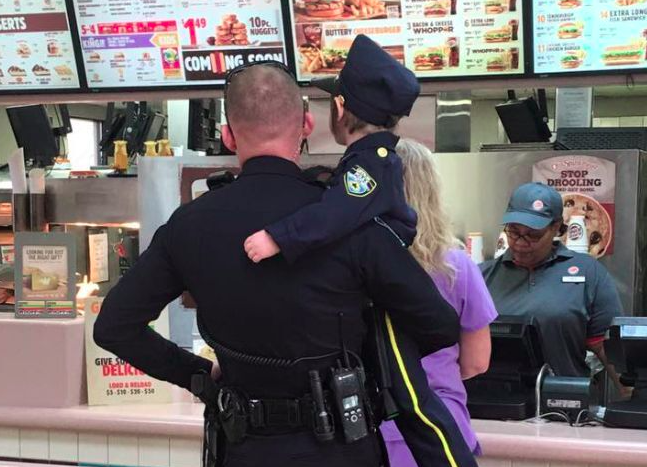It started as an innocent moment: a simple lunch with my five-year-old daughter, Zariah. After a long shift, I picked her up from daycare, still in my police uniform. Zariah, like most kids, loves pretending to be like her parents, so she asked to wear my old patrol cap and pretend to be a cop for a little while. I agreed, thinking it would be a fun way for her to connect with me and my job.
We went to Burger King, where she wore the cap proudly and strutted around like the sheriff of the restaurant. People smiled at her, called her “officer,” and even said it was cute. It was all harmless fun—nothing out of the ordinary. She sat with me in the booth, asking her usual questions about my job as a police officer. I laughed, telling her stories about my partner’s goofy mistakes that morning. She laughed so loud, half the restaurant turned to look.
But then, a woman stood near the soda machine, phone in hand, and I noticed her zooming in on Zariah in her “uniform.” She also took a shot of me, though I didn’t think much of it at the time. I assumed she was just another person noticing the cute moment between a dad and his daughter.
The next morning, everything changed. A coworker texted me a screenshot of a Twitter post featuring me and Zariah. The caption read: “Why are officers letting children cosplay as cops in public? This is messed up.” The post quickly went viral, gaining thousands of likes and comments—many of which criticized me for being unprofessional. Some even tagged my department in the post.
By noon, I was scheduled for a meeting with Internal Affairs. I tried to explain that it was just my daughter playing dress-up, that there was nothing inappropriate about it. But the questions kept coming. They asked about “public perception” and whether I understood how something so small could be misinterpreted. They didn’t seem to be listening to my explanation, and I was left wondering how something so innocent could blow up in such a way.
Then, an unexpected message arrived. It wasn’t from my workplace, but from a woman named Dr. Amari Toussaint, a professor of media ethics at a university in North Carolina. She had seen the post and wanted to discuss the situation with me. At first, I almost ignored it. But there was something in her message that caught my attention—she seemed genuinely interested in understanding my perspective, not just passing judgment.
I decided to respond, and what followed was an hour-long conversation. Dr. Toussaint asked insightful questions about how I balanced being a dad and a cop in a world full of scrutiny. She wanted to know what Zariah’s pretend play meant to her, how she viewed the world, and what it felt like for me to raise her in today’s complex climate. It was a refreshing, open conversation—nothing like the tense meeting I had with Internal Affairs.
A couple of days later, Dr. Toussaint shared our conversation online, with my permission. She explained how dressing up is a way for children to connect with their parents and process emotions. In her post, she shared a photo of Zariah in her “uniform” and talked about how kids often emulate their parents, whether they’re doctors, firefighters, or, in this case, police officers.
The response to Dr. Toussaint’s post was dramatically different from the viral outrage. People began to reflect on their own judgments and shared stories of their children dressing up as professionals they admired. Some even posted photos of their kids wearing toy stethoscopes or fireman helmets. It turned into a conversation about the innocence of childhood imagination and how children connect with their parents through play.
Local news outlets even picked up the story, running a segment titled “When Pretend Meets Real Life: The Dad Behind the Viral Photo.” Zariah stole the show when she said, “I want to be just like my daddy, but I’ll let the bad guys go if they say sorry.” It was a lighthearted moment that shifted the tone of the entire conversation.
By the time I returned to my meeting with Internal Affairs, the situation had changed. The department dropped the investigation. The public’s reaction, as well as support from within my department, helped shift the conversation. My captain even said, “Just be careful where you wear the badge—even the toy ones.”
The situation wasn’t over, though. A few weeks later, Dr. Toussaint invited me to speak on a panel about parenting while in uniform. During the virtual event, I was joined by Zariah, who wore a sparkly headband and held my old patrol cap in her lap. One teacher in the audience said, “Kids see the world through stories. And when they see parents living their values, that’s powerful—no matter what uniform you wear.”
That hit me hard. I realized that Zariah didn’t necessarily want to follow in my footsteps—she just wanted to understand me, to walk beside me, even for a moment, in the shoes I wear every day.
Looking back, this experience taught me a valuable lesson: never let a stranger’s snapshot define your narrative. People will always talk, but the ones who ask thoughtful questions and seek to understand are the voices that matter.
If you’ve ever faced judgment for something small, remember that context matters. And, sometimes, the most powerful stories come from those who take the time to listen.

Sophia Reynolds is a dedicated journalist and a key contributor to Storyoftheday24.com. With a passion for uncovering compelling stories, Sophia Reynolds delivers insightful, well-researched news across various categories. Known for breaking down complex topics into engaging and accessible content, Sophia Reynolds has built a reputation for accuracy and reliability. With years of experience in the media industry, Sophia Reynolds remains committed to providing readers with timely and trustworthy news, making them a respected voice in modern journalism.



